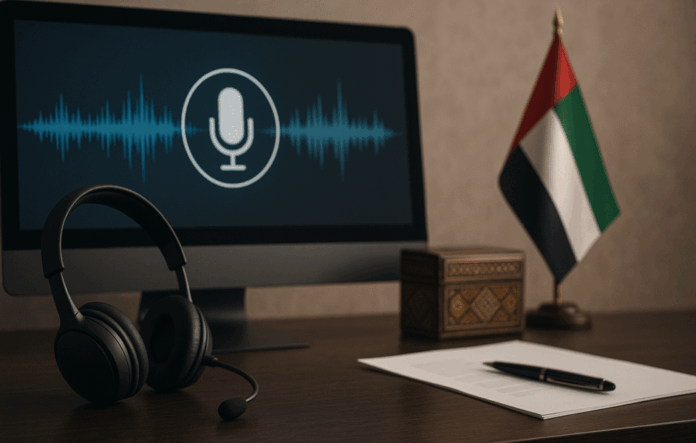Introduction to Munsit: The Arabic Speech Recognition Model
In a groundbreaking achievement for Arabic-language artificial intelligence, CNTXT AI has introduced Munsit, a next-generation Arabic speech recognition model. This model is not only the most accurate ever created for Arabic but also outperforms global giants like OpenAI, Meta, Microsoft, and ElevenLabs on standard benchmarks. Developed in the UAE and tailored for Arabic from the ground up, Munsit represents a significant step forward in what CNTXT calls “sovereign AI”—technology built in the region, for the region, yet with global competitiveness.
The Science Behind Munsit
The scientific foundations of this achievement are laid out in the team’s newly published paper, which introduces a scalable, data-efficient training method that addresses the long-standing scarcity of labeled Arabic speech data. This method, known as weakly supervised learning, has enabled the team to construct a system that sets a new bar for transcription quality across both Modern Standard Arabic (MSA) and more than 25 regional dialects.
Overcoming the Data Drought in Arabic ASR
Arabic, despite being one of the most widely spoken languages globally and an official language of the United Nations, has long been considered a low-resource language in the field of speech recognition. This stems from both its morphological complexity and a lack of large, diverse, labeled speech datasets. Unlike English, which benefits from countless hours of manually transcribed audio data, Arabic’s dialectal richness and fragmented digital presence have posed significant challenges for building robust automatic speech recognition (ASR) systems.
The Approach to Weak Supervision
Rather than waiting for the slow and expensive process of manual transcription to catch up, CNTXT AI pursued a radically more scalable path: weak supervision. Their approach began with a massive corpus of over 30,000 hours of unlabeled Arabic audio collected from diverse sources. Through a custom-built data processing pipeline, this raw audio was cleaned, segmented, and automatically labeled to yield a high-quality 15,000-hour training dataset—one of the largest and most representative Arabic speech corpora ever assembled.
The Conformer Architecture
At the heart of Munsit is the Conformer model, a hybrid neural network architecture that combines the local sensitivity of convolutional layers with the global sequence modeling capabilities of transformers. This design makes the Conformer particularly adept at handling the nuances of spoken language, where both long-range dependencies (such as sentence structure) and fine-grained phonetic details are crucial.
Training the Model
CNTXT AI implemented a large variant of the Conformer, training it from scratch using 80-channel mel-spectrograms as input. The model consists of 18 layers and includes roughly 121 million parameters. Training was conducted on a high-performance cluster using eight NVIDIA A100 GPUs with bfloat16 precision, allowing for efficient handling of massive batch sizes and high-dimensional feature spaces.
Dominating the Benchmarks
The results speak for themselves. Munsit was tested against leading open-source and commercial ASR models on six benchmark Arabic datasets: SADA, Common Voice 18.0, MASC (clean and noisy), MGB-2, and Casablanca. These datasets collectively span dozens of dialects and accents across the Arab world, from Saudi Arabia to Morocco.
Performance Comparison
Across all benchmarks, Munsit achieved an average Word Error Rate (WER) of 26.68 and a Character Error Rate (CER) of 10.05. By comparison, the best-performing version of OpenAI’s Whisper recorded an average WER of 36.86 and CER of 17.21. Meta’s SeamlessM4T, another state-of-the-art multilingual model, came in even higher. Munsit outperformed every other system on both clean and noisy data, and demonstrated particularly strong robustness in noisy conditions, a critical factor for real-world applications like call centers and public services.
A Platform for the Future of Arabic Voice AI
While Munsit is already transforming the possibilities for transcription, subtitling, and customer support in Arabic-speaking markets, CNTXT AI sees this launch as just the beginning. The company envisions a full suite of Arabic-language voice technologies, including text-to-speech, voice assistants, and real-time translation systems—all grounded in sovereign infrastructure and regionally relevant AI.
The Future of AI
“Munsit is more than just a breakthrough in speech recognition,” said Mohammad Abu Sheikh, CEO of CNTXT AI. “It’s a declaration that Arabic belongs at the forefront of global AI. We’ve proven that world-class AI doesn’t need to be imported — it can be built here, in Arabic, for Arabic.”
Conclusion
With the rise of region-specific models like Munsit, the AI industry is entering a new era—one where linguistic and cultural relevance are not sacrificed in the pursuit of technical excellence. In fact, with Munsit, CNTXT AI has shown they are one and the same. The introduction of Munsit marks a significant milestone in the development of Arabic-language artificial intelligence, setting a new standard for speech recognition and paving the way for a future where AI is more inclusive and accessible to diverse populations around the world.

